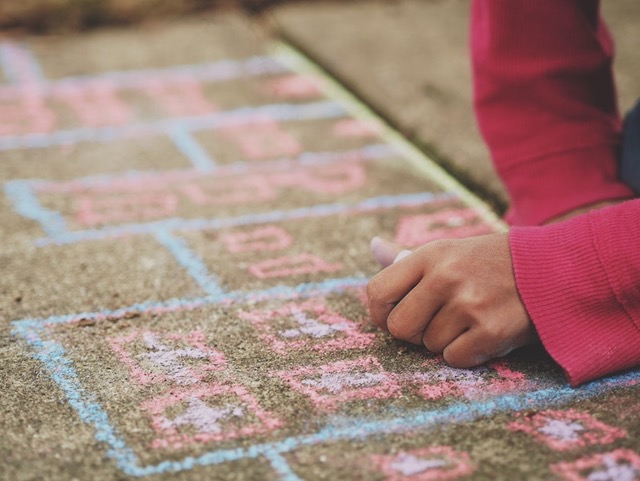City schools and outside play

Nearly three decades ago when I was knee-high and full of bounce, I used to spend most days outside. Wind-beaten and pigtails askew, I had the best schooling experience in a state school that embraced its outside spaces. When it was raining the mentality of ‘you won’t shrink’ meant that play times were unperturbed by wet weather and muddy knees and a damp pinafore were the Autumn/Winter look.
A change in the air
When I trained as a teacher a decade, ago it was apparent that something had changed. Maybe not in all schools. Maybe it was not lost completely but there was a national recognition that we should all turn to our Norwegian peers and embrace the outdoors. After all, they ranked second in the UNICEF study of the overall well-being of children league table. This was an interesting time to train as an Early Years teacher with my more seasoned counterparts informing me that guidance and policies all go around in circles depending on current trends. The part that made me curious though was how do city schools accomplish providing their pupils with effective outside play? After all, education should not be a postcode lottery of teaching standards that children receive nor should a child be at a disadvantage in their access to outside play determined by attending a ‘city’ school.
Making outside play work in a city environment
Outside play spaces can be created within a school grounds to draw in and support nature and give a varied experience. In urban schools, it does not need to be a designated space with fixed slides and climbing frames because space is generally a precious premium. Innovative play systems, like Kitcamp, can be more beneficial in creating more varied and imaginative play spaces; transforming uninspiring spaces into areas of exploration.
These plays spaces can work alongside urban conservation needs, as our presence grows and habitat spaces increase. Other ideas for schools in city environments, which give their pupils and staff outside time to embrace our environment and learn from it, could be as follows:
Make a local search of your area.
Cities such as London have many parks that are accessible as well as the London Wildlife Trust that is utilised by London Borough schools and beyond for its outdoor learning opportunities. Outside play perimeters can be identified within a ten-minute radius of a school for weekly trips. Often, local searches can turn out gems of experiences for children and staff. The ‘popping distance’ options mapped out can also provide a broader perspective of the school’s locality. These options require travel beyond the school’s environment to explore but there is not always the time and flexibility in the curriculum for delivery of mass movement beyond the gates on a daily basis. This does not mean that lessons cannot happen outside the classroom door but it does mean to open the discussion with pupils and parents on how to make the outside spaces more usable for stimulating lessons beyond four walls.

Let the bugs come to you.
Outdoor spaces can be created within a school’s grounds to draw in nature and give a varied learning experience. In city and town schools it does not need to be a designated space with fixed slides and climbing frames because space is generally precious. Outside learning can develop organically from the children. Get comfortable with the environment by setting the children off on finding challenges or getting them to design a space to work towards. Bring new life to abandoned corners with fallen tree trunks and large branches to generate mini-beast interest. I have always encouraged a bug hotel and bucket ponds where space is limited and make your own bird boxes as a class DT project.
Grow your own classroom.
Living walls growing wildflowers are great for drawing in wildlife to a concrete corner. The Woodland Trust has a great offer for schools to apply for a free tree pack that contains 30 saplings. A fantastic resource for creating a potted forest area or natural screen to subdivide play spaces and give shelter for outside lessons.
Visually stimulating spaces lend themselves as a backdrop to imaginative play, as well as relaxed exploratory learning. Whatever the class activity, think: could we do this outside? Is it necessary to be in class? With greater use of these areas, more inspiration for what the pupils foresee as potential changes will come.
Outside learning is a mindset
Familiarity comes with regular practice; outside learning should not be set apart as a special one-off box-ticking exercise. It is a mindset and one that is proven through various studies, including the ‘Natural Connections Demonstration Project’ report published by Natural England. The four-year initiative, which was the largest of its kind, sought to help school children to access their natural environment and the experiences that come with this. The support given to teachers in using the outdoors gave teachers the planning tools and practice to supply high quality learning outside the classroom in the natural environment. The publication evidenced that 95 percent of surveyed children said ‘outdoor learning makes lessons more enjoyable’ as well as 90 percent saying that ‘they felt happier and healthier’.
95 percent of surveyed children said ‘outdoor learning makes lessons more enjoyable’.
What we can do to make a difference.
Parents in society are recognising change by getting back on the streets with their children and the importance of play to tackle health issues such as low mood and obesity that is a growing issue (forecast to cost the NHS £50 billion by 2050). Families in built-up areas have grouped together to close streets for a couple of hours a day to allow children social opportunities for physical play within their local community. This original idea spread from a group in Bristol that worked with the local council to make change happen. The spotlight has also been put on safe outside play opportunities being built into new developments from the initial planning stages. The UK’s National House Building Council (NHBC) are working in collaboration with ZCD Architects to pilot projects whereby new developments will put children’s well-being as a priority in the outside safe spaces.
Cities and towns have their own unique environments. The trick is playing to your strengths and what is local to you. There is not an overnight solution. A school’s best asset is the one they get for free; the children! It is tapping into their curiosities and opening the door to the outside world. Take the books with you and the notepads to capture the experience. Make a space outside the classroom door that changes with the seasons and even bring the outdoors inside with a windowsill full of life. Connect with the outside, become multifunctional in your approach to generate a mindset that sees the local outside bench as a regular day in the office.
Kitcamp provides a tool for connecting with the outside, which is ideal for city schools. Children can build outdoor play environments to their own design and enjoy the opportunities this brings for breathing fresh air whilst driving imaginative play. For limited outdoor play space, it has the benefit of easy, compact storage out of the way when not needed or in use. Contact us for more information.
Credit: Bug House Photo by Annie Spratt on Unsplash
